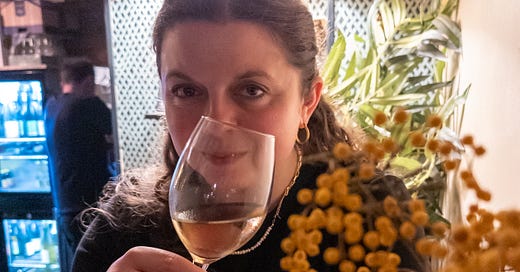I still remember the first time I had a good glass of wine. I was on a terrace in Paris with my grandmother. We were in the city for a week before heading to Florence for the second half of our trip, and the waiter was flirting with her. (Not surprising, my grandmother is hot.) She ordered two glasses of wine—one for her, one for me. I was sixteen.
And before you come at me, yes. It was legal then.
I don’t remember what kind of wine it was. Looking back at the photo she took of me and examining closely, I’m assuming from the deep color intensity that it was something from Bordeaux or the Côtes du Rhône. But I do remember sipping on it, and even at sixteen I knew it was good.
I asked either the waiter or my grandmother, “why does it taste this way?”
One of them responded with, “a good glass of wine should taste like a toasted slice of good bread slathered in butter.”
The comparison stuck with me, and from that point on, I was ruined for life.
I have been chasing that particular tasting note for over a decade since. It was easy for me to pluck out crappy tasting wine, like the kind passed in secret in college dorm rooms or sold at the 7-11 for $6.99. I didn’t bother drinking much wine in my early twenties because I knew I couldn’t afford the good stuff, so I didn’t bother. The only time I did enjoy a glass was at family gatherings when my dad or Uncle Jeff would choose the wine for dinner, and it always hit that familiar spot.
Knowing what I know now, I realize that at the time I was enjoying well made wine red wine that sat in French oak. Not necessarily wine in American oak, which gives more of an intense chocolate and vanilla character. (Lovely in its own way.) But French oak, which is a touch more neutral in its expression, giving off that toasty, bready quality with warming kitchen spices like cinnamon, clove, and all spice. The butter tasting note is likely from wine that sat on the lees (gives off a creamy mouthfeel) and aged in some capacity. In the case of white wine, the butter quality can come across through the process of malolactic fermentation, as well as time sat in oak.
As I grew older—and my palate expanded—I found other tasting notes that I enjoyed. High acid white wines with notes of tropical fruits. (Hello, Marlborough Sauvignon Blanc.) Medium-bodied red wines with lots of tannins and savory notes. (Hello, Chianti Classico.) And an appreciate for aged fortified wines that taste like a piece of caramel melting on your tongue. (Hello, Madeira.)
But this moment in particular, the one where I sat on a terrace at sixteen and enjoyed my first glass of wine, was the moment that ruined me. I couldn’t simply enjoy a glass of wine. I couldn’t be the kind of girl at a party that would say “I’ll drink whatever” and be happy about it. I was shoved into the category of “wine snob” and honestly, I didn’t hate it in my little corner. It did mean I had to say no to wine for a long time. But I knew what I liked, and I was willing to wait for the good stuff. I was willing to work hard so I could afford the good stuff.
I laugh about this moment now, thinking about the ways my taste for good wine has followed me over the years. Like how a stunning glass of dry Riesling in Baden, Germany easily turned into two glasses, then three, then a drunk text to a cute boy who became my husband two years later. (A story for another time, I promise.) Or how a taste of a 1993 Stags Leap Cabernet Sauvignon made me realize the complexities that come with aging a wine…and how maybe I care more about the world of wine and should do something about it.
In my twenties, I would look back at that glass of red on a terrace in Paris as a curse I was burdened to carry. You ruined me for life.
But now, on the precipice of a new kind of career, I wonder if it was merely meant for me all along. A curse that transformed into a blessing. A glass of wine that seemed like nothing at the time, but ultimately changed my life.
Wine of the week
I didn’t get a ton of chances to try new wine this week, so I’ll feature another wine that I loved from our recent trip to the Finger Lakes. This is Osmote’s 2024 Chardonnay, off of Cayuga Lake.
Tasting notes:
Appearance: Green yellow, pale intensity
Nose: Green apple, melon, lots of minerality, no evidence of oak
Palate: High acidity, light body, medium alcohol, no oak, very long length
My conclusion: Lean, easy drinking, really nice for green salads and vegetables.







